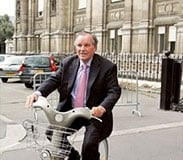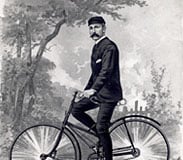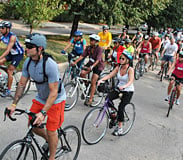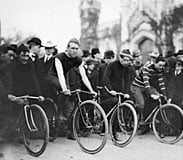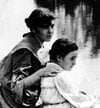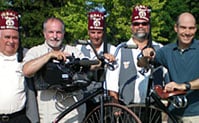The history of the bicycle begins with an 1817 invention by German engineer Baron Karl Dreiss von Sauerbronn. The Baron called his invention a "Swift Walker," and although it had no pedals, the body of the Swift Walker resembled the modern bicycle. A Scottish blacksmith added pedals to the body of Dreiss von Sauerbronns contraption in the late 1830s, but the design was awkward and it was not until Parisian blacksmith Pierre Michaux attached the pedals to the hub of a large front wheel in 1861 that the bicycle began to attract massive public attention.
The first bicycles appeared in the United States during the late 1860s. Known as "velocipedes" or "boneshakers," these early bikes were both extremely expensive and difficult to maneuver. Despite the price and physical strength necessary to manipulate early models, which could weigh up to 150 pounds, the bicycle became a popular novelty among wealthy young men. By the 1870s, the high-wheeler reached Chicago, which made cycling easier, although a rider would need to climb atop a 54-inch front wheel.
It was not until the "safety bike" was introduced in the 1890s that a major shift occurred in the bicycle industry. The "safety bike" returned the wheel arrangement to that of the velocipede. Its light tubular frame and pneumatic tires were radically innovative. However, it was the sprocket-and-chain system, which carried power from the pedals to the back wheel that made the safety bike easier to ride and transformed cycling from a high-class form of leisure to a popular form of recreation available to a diversity of men and women.
The new bicycle model offered women of the time a kind of mobility they had never known. A new class of wheelwomen became both revolutionary and a symbol of the expansion of women's role in society. The first bicycles designed for female riders were constructed to allow women to ride without sacrificing their modest and dignified Victorian attire. However, wheelwomen soon opted for the more practical bloomers and divided skirts. Wheelwomen and their shocking fashions were controversial subjects among both men and women of the time. Bicycle manufacturers were acutely sensitive to the opportunities and problems this new group of cyclists could have on business. They quickly began designing a diversity of new bicycles, clearly articulating the difference between men and women's models. By gendering the bicycle, manufacturers were able to profit from a seemingly threatening emergence of the female cyclist and still preserve many of societys gender expectations.
At the turn of the century, the price of bicycles dramatically dropped. As bicycle technology advanced and the sport became more popular, the bicycle manufacturing market became saturated. A high-wheel bicycle could run as much as $300 during the 1870s – nearly one years wages for the average worker – but by the late 1890s, a bargain hunter could find a good used or "shopworn" model for as little as $35, transforming the bicycle from a rich mans toy to a product of the populace.
During the 1920s, bicycle manufacturers such as Schwinn began to focus not only on the quality of their bicycles but also on appearance. The 1934 Schwinn Aerocycle was designed to resemble airplanes, streamlined automobiles, and motorcycles. In 1948, Schwinn introduced the Black Phantom, which became an instant American classic. The popularity of the Phantom was soon surpassed by the 1963 Sting-Ray. The bikes high-rise handlebars and banana seat soon become the most popular features in bicycle design.
In the 1970s and 1980s, new bike models became popular among teens and young adults. BMX bikes were designed for motocross racing on dirt paths. These races remain popular extreme sporting events today. The mountain bike was another model designed for non-traditional racing. While there is some question concerning the actual origin of this model, there is no question that mountain bikes were initially designed for racing down high-altitude mountain paths.
During late 19th century, Chicagoans were crazy for the bicycle. The city of nearly 2 million residents was a haven for cyclists with close to 2,000 miles of roads, many paved. The development of parks and tree-lined streets a short distance from the overcrowded tenement neighborhoods provided riders with a cycling sanctuary. Men, women, and children all cycled as both a leisure activity and as a means of transportation. However, the auto boom had an enormous impact on the city. The car soon trumped the bicycle and automobiles began to dominate the streets, causing safety hazards for cyclists.
Today, there is an almost inexhaustible number of bicycle makes and models. Cyclists have options that early bike riders would have never been able to imagine. Experts suggest that cyclists consider a number of factors before choosing a bicycle. Cost, size, terrain, comfort, speed, and weight should all be considered prior to purchasing a bike. Most dealers allow prospective buyers the opportunity to test-ride a bicycle, and with so many choices, test-riding a bike is one of the best ways to determine if a particular model is a good fit for the rider.
By the 1970s, gas prices began to soar and communities began to express concern about energy conservation and air pollution. Once again, the bicycle became a popular means of transportation for Chicagoans. Mayor Richard J. Daley and his administration began plans to develop the citys bikeway system. The team worked to create Chicagos first on-street cycle routes and commissioned rush-hour bike lanes on Clark and Dearborn Streets.
Following in his fathers footsteps, Mayor Richard M. Daley continued to make Chicago an ideal city for cyclists, which in part meant ensuring that city streets were more bike-friendly. In 1992, the Mayors Bicycle Advisory Council prepared the Bike 2000 Plan, which presented 31 recommendations to encourage bicycling in Chicago. Based on these recommendations, the City of Chicago established a network of 100 miles of on-street bike lanes. By 2002, the mayors administration had begun collaboration with the Department of Transportation and the Chicagoland Bicycle Federation to present the Bike 2015 Plan, which will ensure the continuation of previous plans.



